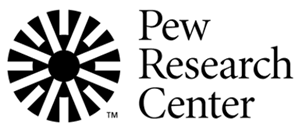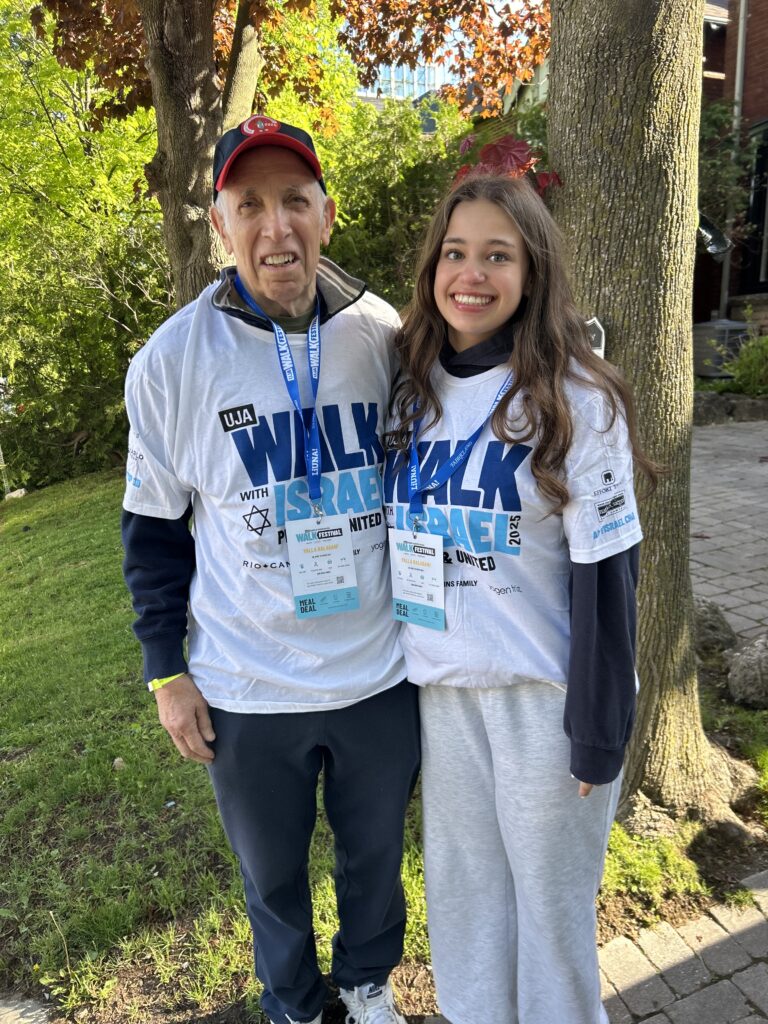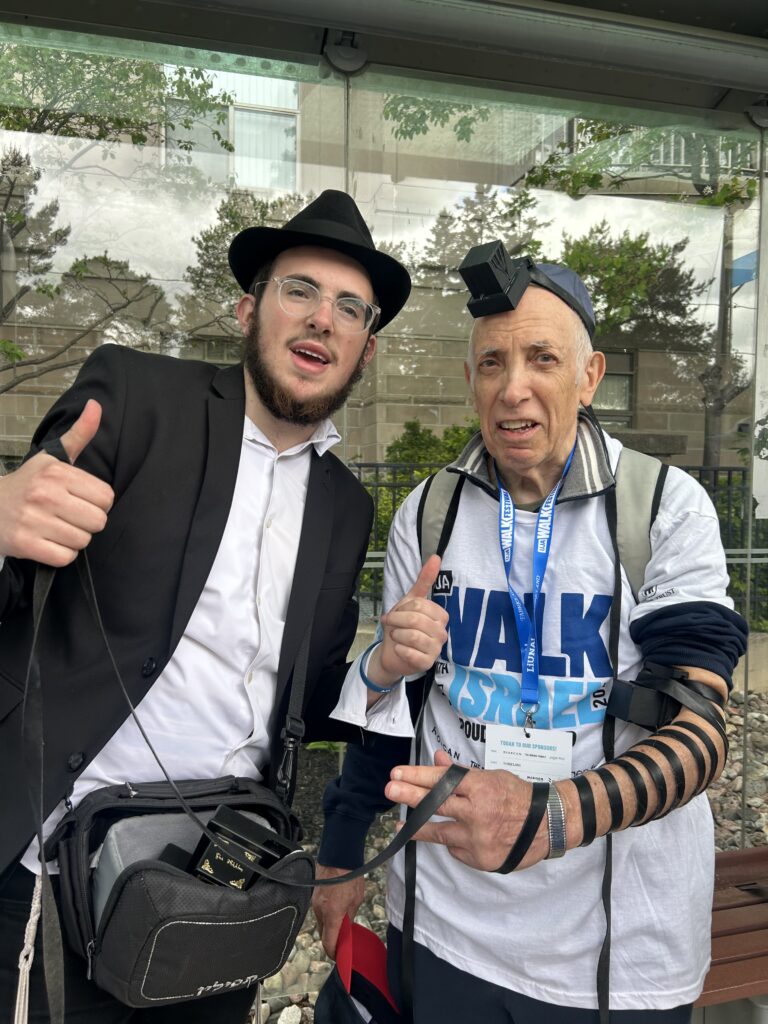Uncategorized
Visiting Jerusalem, Ron DeSantis tries out his Jewish stump speech
JERUSALEM (JTA) — Ron DeSantis may not have declared that he’s running for president yet, but his incipient campaign was on full display Thursday at a conference in Jerusalem, where he ran down a laundry list of issues relevant to Israel and American Jews.
Most of the Florida governor’s remarks reflected what has become Republican orthodoxy in the post-Donald Trump era: He supports Israeli West Bank settlements as well as keeping Jerusalem under full Israeli control. He wants the United States to be more aggressive toward Iran’s nuclear program. He vehemently opposes the movement to boycott Israel.
And he declined to take a position on the Israeli government’s effort to sap the Israeli Supreme Court of much of its power — which President Joe Biden has repeatedly criticized as a danger to Israeli democracy.
“We must also, in America, respect Israel’s right to make its own decisions about its own governance,” he said. “You’re a smart country. You figure it out. It shouldn’t be for us to butt into these important issues.”.
He also pushed back at claims that his legislation has led to the banning of Holocaust books in his state, calling them “fake narratives” (though multiple Holocaust books have been banned). And, at a press conference, he signed a bill that aims to penalize antisemitic harassment. He also touted a new bill that gives vouchers worth thousands of dollars to parents who send their children to private schools.
“We’ve really seen a historic migration of American Jews and Israeli Americans moving to southern Florida,” he said. “It’s really, really boomed, and I think Florida’s policies have really reinforced that.”
DeSantis, who landed in Israel yesterday, was the keynote speaker at a conference on Thursday hosted by the Jerusalem Post at the Museum of Tolerance here. He received multiple standing ovations and cheers throughout the morning. At a press conference after his speech, some of his supporters sat among the journalists and clapped at his responses.
Israel is the latest on a four-stop international trip by DeSantis, who is expected to announce later this year that he will challenge former President Donald Trump for the Republican presidential nomination. On the trip, he is meeting with Israeli Prime Minister Benjamin Netanyahu, President Isaac Herzog and other officials. His trip also includes stops in Japan, South Korea and the United Kingdom.
“If there’s any announcements, those will come at the appropriate time,” he said in response to a question about his potential candidacy.
In his speech, DeSantis described his past support for Israel, advocating for the 2018 move of the U.S. embassy from Tel Aviv to Jerusalem and, in 2019, holding a Florida cabinet meeting in Jerusalem. He also told the crowd that he baptized his children with water from the Sea of Galilee and said he put a note in the Western Wall asking God to protect Florida from hurricane season.
An affinity for the Bible also played a role in DeSantis’ position on the West Bank, which he called “disputed” rather than “occupied.” He referred to the territory by the term “Judea and Samaria,” which is the Israeli government’s standard term for the area and also emphasizes its place in the Bible. He spoke of visits to the northern West Bank settlement of Ariel, as well as to the City of David, a Jewish neighborhood and archaeological site in eastern Jerusalem.
“We visited the Biblical heartland of Judea and Samaria,” he said during his speech regarding a previous trip. Later, at the press conference, he said, “Those are the most historic Jewish lands there are, going back thousands and thousands of years.”
He also came out staunchly in favor of continued Israeli control of eastern Jerusalem, claiming that it is the best way to ensure religious freedom in the city. Palestinians aspire for the city’s eastern area to be the capital of a future Palestinian state.
“With Israeli sovereignty over the city of Jerusalem, people have the ability to practice their religion freely,” he said. “They have the ability to visit their sites freely. That would just actually not be true if that were in other hands.”
Although his Israel policies dovetail with those of Trump, and even though Trump’s Israel ambassador, David Friedman, was at the conference, DeSantis avoided saying the former president’s name in his speech, instead referring to “the previous administration.” He did say Trump’s name once during the press conference.
Following his speech, DeSantis announced partnerships with Israeli firms to develop tech products, and portrayed his state as an inviting home for Jews. He said the state had invested millions of dollars into synagogue security as well as Holocaust education. And he signed a bill that bans projecting threatening images on buildings without permission, as well as littering with the intent to intimidate.
Florida has seen an uptick recently in white supremacist activity. The Goyim Defense League, a far-right antisemitic group, relocated there last year. In October, several public spaces in Jacksonville displayed messages promoting the antisemitic ideas of rapper Kanye West. Neo-Nazis intimidated attendees at an Orlando-area Chabad center in February, and last week, police arrested a man for a March attack on a different Florida Chabad center.
“This is going to be able to provide more tools to be able to combat antisemitic activity,” DeSantis said. ״If you have a synagogue and someone shines a swastika-like image on that, they have a right to do the image for themselves, but putting it on someone else’s property, they’re defining that in this bill as a trespass.”
The signing of that bill, and DeSantis’ contention that he supports Holocaust education, comes as legislation he signed has enabled parents in the state to pursue bans of Holocaust literature. A South Florida school district library removed a Holocaust-themed novel by Jodi Picoult in March, and this month, a high school in the state removed a graphic novel adaptation of Anne Frank’s diary from its shelves.
Despite those instances and other bans parents are seeking, DeSantis claimed that there was no significant campaign to ban Holocaust books. He called that allegation the “book ban hoax.”
“Those are all fake narratives,” he said. “We’ve provided curriculum transparency for parents, to make sure that the curriculum used in school is transparent and to make sure everything is age appropriate and is not conflicting with Florida standards. And so, what parents have identified unfortunately are pornographic images in books.”
The legislation, which has targeted books about sexuality and gender, is at the center of DeSantis’ campaign to limit or ban discussion of those topics in schools. The law, called the “Parental Rights in Education” bill and dubbed by critics as the “Don’t say gay” bill, also bans discussion of LGBTQ topics between kindergarten and third grade, among other measures. It is one of a series of recent state laws limiting transgender rights.
That law is also at the center of DeSantis’ feud with Disney, the state’s largest employer, which just sued the governor for allegedly punishing the company for its criticism of the law. At the press conference, DeSantis said the suit is about Disney wanting “to be able to control things without proper oversight.”
DeSantis did not refer specifically to the Anne Frank graphic novel in his remarks, and said Florida had “beefed up” Holocaust education in the state. But a Jewish ally of his who accompanied him on the trip, Republican state Rep. Randy Fine, defended banning the book, which he called the “Anne Frank pornography book.”
“I read the diary of Anne Frank many times as a kid and I don’t remember any of that stuff that they put in that graphic novel,” Fine told the Jewish Telegraphic Agency. “And frankly that graphic novel is antisemitic. To sexualize the diary of Anne Frank in that sort of inappropriate way, it is antisemitic.”
When told that the passages, which are authentic and relate to Frank’s attraction to another girl as well as a description of her own genitalia, have been included in the diary for decades, Fine said that the graphic novel was inappropriate regardless because it depicted the passages in an image.
“It wasn’t just that the passages were in the book,” he said. “It was how they were visualized.”
—
The post Visiting Jerusalem, Ron DeSantis tries out his Jewish stump speech appeared first on Jewish Telegraphic Agency.
Uncategorized
How the Global Religious Landscape Changed from 2010 to 2020

Muslims grew fastest; Christians lagged behind global population increase
• Christians are the world’s largest religious group, at 28.8% of the global population. They are a majority everywhere except the Asia-Pacific and Middle East-North Africa regions. Sub-Saharan Africa has surpassed Europe in having the largest number of Christians. But Christians are shrinking as a share of the global population, as millions of Christians “switch” out of religion to become religiously unaffiliated.

• Muslims are the world’s second-largest religious group (25.6% of the world’s population) and the fastest-growing major religion, largely due to Muslims’ relatively young age structure and high fertility rate. They make up the vast majority of the population in the Middle East-North Africa region. In all other regions, Muslims are a religious minority, including in the Asia-Pacific region (which is home to the greatest number of Muslims).

• The religiously unaffiliated population is the world’s third-largest religious category (24.2% of the global population), after Christians and Muslims. Between 2010 and 2020, religiously unaffiliated people grew more than any group except Muslims, despite their demographic disadvantages of an older age structure and relatively low fertility. The unaffiliated made up a majority of the population in 10 countries and territories in 2020, up from seven a decade earlier.
• Hindus are the fourth-largest religious category (14.9% of the world’s population), after Christians, Muslims and religiously unaffiliated people. Most (99%) live in the Asia-Pacific region; 95% of all Hindus live in India alone. Between 2010 and 2020, Hindus remained a stable share of the world’s population because their fertility resembles the global average, and surveys indicate that switching out of or into Hinduism is rare.
• Buddhists (4.1% of the world’s population) are the only group in this report whose number declined worldwide between 2010 and 2020. This was due both to religious disaffiliation among Buddhists in East Asia and to a relatively low birth rate among Buddhists, who tend to live in countries with older populations. Most of the world’s Buddhists (98%) reside in the Asia-Pacific region, the birthplace of Buddhism.
• Jews, the smallest religious group analyzed separately in this report (0.2% of the world’s population), lagged behind global population growth between 2010 and 2020 – despite having fertility rates on par with the global average – due to their older age structure. Most Jews live either in North America (primarily in the United States) or in the Middle East-North Africa region (almost exclusively in Israel).
These are among the key findings of a Pew Research Center analysis of more than 2,700 censuses and surveys, including census data releases that were delayed due to the coronavirus pandemic. This report is part of the Pew-Templeton Global Religious Futures project, which analyzes global religious change and its impact on societies around the world. Funding for the Global Religious Futures project comes from The Pew Charitable Trusts and the John Templeton Foundation.
Uncategorized
Antisemitism in some unlikely places in America

By HENRY SREBRNIK Antisemitism flourishes in a place where few might expect to confront it – medical schools and among doctors. It affects Jews, I think, more emotionally than Judeophobia in other fields.
Medicine has long been a Jewish profession with a history going back centuries. We all know the jokes about “my son – now also my daughter – the doctor.” Physicians take the Hippocratic Oath to heal the sick, regardless of their ethnicity or religion. When we are ill doctors often become the people who save us from debilitating illness and even death. So this is all the more shocking.
Yes, in earlier periods there were medical schools with quotas and hospitals who refused or limited the number of Jews they allowed to be affiliated with them. It’s why we built Jewish hospitals and practices. And of course, we all shudder at the history of Nazi doctors and euthanasia in Germany and in the concentration camps of Europe. But all this – so we thought – was a thing of a dark past. Yet now it has made a comeback, along with many other horrors we assume might never reappear.
Since the Hamas attack on Israel on October 7, 2023, there has been a resurgence of antisemitism, also noticeable in the world of healthcare. This is not just a Canadian issue. Two articles on the Jewish website Tablet, published Nov. 21, 2023, and May 18, 2025, spoke to this problem in American medicine as well, referencing a study by Ian Kingsbury and Jay P. Greene of Do No Harm, a health care advocacy group, based on data amassed by the organization Stop Antisemitism. They identified a wave of open Jew-hatred by medical professionals, medical schools, and professional associations, often driven by foreign-trained doctors importing the Jew-hatred of their native countries, suggesting “that a field entrusted with healing is becoming a licensed purveyor of hatred.”
Activists from Doctors Against Genocide, American Palestinian Women’s Association, and CODEPINK held a demonstration calling for an immediate cease-fire in Gaza at the Hart Senate Office Building in Washington, D.C., Nov. 16, 2023, almost as soon as the war began. A doctor in Tampa took to social media to post a Palestinian flag with the caption “about time!!!” The medical director of a cancer centre in Dearborn, Michigan, posted on social media: “What a beautiful morning. What a beautiful day.” Even in New York, a physician commented on Instagram that “Zionist settlers” got “a taste of their own medicine.” A Boston-based dentist was filmed ripping down posters of Israeli victims and a professor at the University of Pennsylvania Perelman School of Medicine did the same. Almost three-quarters of American medical associations felt the need to speak out on the war in Ukraine but almost three-quarters had nothing to say about the war in Israel.
Antisemitism in academic medical centres is fostering noxious environments which deprive Jewish healthcare professionals of their civil right to work in spaces free from discrimination and hate, according to a study by the Data & Analytics Department of StandWithUs, an international, non-partisan education organization that supports Israel and fights antisemitism.
“Academia today is increasingly cultivating an environment which is hostile to Jews, as well as members of other religious and ethnic groups,” StandWithUs director of data and analytics, and study co-author, Alexandra Fishman, said on May 5 in a press release. “Academic institutions should be upholding the integrity of scholarship, prioritizing civil discourse, rather than allowing bias or personal agendas to guide academic culture.”
The study, “Antisemitism in American Healthcare: The Role of Workplace Environment,” included survey data showing that 62.8 per cent of Jewish healthcare professionals employed by campus-based medical centres reported experiencing antisemitism, a far higher rate than those working in private practice and community hospitals. Fueling the rise in hate, it added, were repeated failures of DEI (diversity, equity, and inclusion) initiatives to educate workers about antisemitism, increasing, the report said, the likelihood of antisemitic activity.
“When administrators and colleagues understand what antisemitism looks like, it clearly correlates with less antisemitism in the workplace,” co-author and Yeshiva University professor Dr. Charles Auerbach reported. “Recognition is a powerful tool — institutions that foster awareness create safer, more inclusive environments for everyone.”
Last December, the Data & Analytics Department also published a study which found that nearly 40 per cent of Jewish American health-care professionals have encountered antisemitism in the workplace, either as witnesses or victims. The study included a survey of 645 Jewish health workers, a substantial number of whom said they were subject to “social and professional isolation.” The problem left more than one quarter of the survey cohort, 26.4 per cent, “feeling unsafe or threatened.”
The official journal of the Alliance for Academic Internal Medicine concurs. According to “The Moral Imperative of Countering Antisemitism in US Medicine – A Way Forward,” by Hedy S. Wald and Steven Roth, published in the October 2024 issue of the American Journal of Medicine, increased antisemitism in the United States has created a hostile learning and practice environment in medical settings. This includes instances of antisemitic behaviour and the use of antisemitic symbols at medical school commencements.
Examples of its impact upon medicine include medical students’ social media postings claiming that Jews wield disproportionate power, antisemitic slogans at the University of California, Los Angeles (UCLA) David Geffen School of Medicine, antisemitic graffiti at the University of California, San Francisco (UCSF) Cancer Centre, Jewish medical students’ exposure to demonization of Israel diatribes and rationalizing terrorism; and faculty, including a professor of medicine at UCSF, posting antisemitic tropes and derogatory comments about Jewish health care professionals. Jewish medical students’ fears of retribution, should they speak out, have been reported. “Our recent unpublished survey of Jewish physicians and trainees demonstrated a twofold increase from 40% to 88% for those who experienced antisemitism prior to vs after October 7,” they stated.
In some schools, Jewish faculty are speaking out. In February, the Jewish Faculty Resilience Group at UCLA accused the institution in an open letter of “ignoring” antisemitism at the School of Medicine, charging that its indifference to the matter “continues to encourage more antisemitism.” It added that discrimination at the medical school has caused demonstrable harm to Jewish students and faculty. Student clubs, it said, are denied recognition for arbitrary reasons; Jewish faculty whose ethnic backgrounds were previously unknown are purged from the payrolls upon being identified as Jews; and anyone who refuses to participate in anti-Zionist events is “intimidated” and pressured.
Given these findings, many American physicians are worried not only as Jewish doctors and professionals, but for Jewish patients who are more than ever concerned with whom they’re meeting. Can we really conceive of a future where you’re not sure if “the doctor will hate you now?”
Henry Srebrnik is a professor of political science at the University of Prince Edward Island.
Uncategorized
The 2025 Toronto Walk (and talk ) for Israel

By GERRY POSNER There are walks and then there are walks. The Toronto UJA Walk for Israel on May 25, 2025 was one of a kind, at least as far as Canada and Jews are concerned. The number of people present was estimated to be 56,000 people or 112,000 total shoes. (How they get to that number is bewildering to me, since there is no one counting). This was 6,000 more than last year. Whether it is true or not, take it from me, it was packed. The synagogues in Canada should be so fortunate to get those numbers in total on High Holidays. The picture here gives you a sense of the size of the crowd.

This was my first walk in Toronto for Israel and I was with my granddaughter, Samantha Pyzer (not to forget her two friends whom she managed to meet at the site, no small feat, even with iPhones as aids). The official proceedings began at 9:00 a.m. and the walk at 10:00 a.m. There was entertainment to begin with, also along the way, and at the finish as well. The finish line this year was the Prosserman Centre or the JCC as it often called. The walk itself was perhaps 4 kilometres – not very long, but the walking was slow, especially at the beginning. There were lots of strollers, even baby carriages, though I did not see any wheelchairs. All ages participated on this walk. I figured, based on what I could see on the faces of people all around me that, although I was not the oldest one on the walk, I bet I made the top 100 – more likely the top 20.
What was a highlight for me was the number of Winnipeggers I met, both past and present. Connecting with them seemed to be much like a fluke. No doubt, I missed la lot of them, but I saw, in no particular order (I could not recall the order if my life depended on it): Alta Sigesmund, (who was, a long time ago, my daughter Amira’s teacher), Marni Samphir, Karla Berbrayer and her husband Dr. Allan Kraut and family. Then, when Samantha and I made it to the end and sat down to eat, I struck up a conversation with a woman unknown to me and as we chatted, she confirmed her former Winnipeg status as a sister-in- law to David Devere, as in Betty Shwemer, the sister of Cecile Devere. I also chanced upon Terri Cherniack, only because I paused for a moment and she spotted me. As we closed in near the finish, I met ( hey were on their way back), Earl and Suzanne Golden and son Matthew, as well as Daniel Glazerman. That stop caused me to lose my granddaughter and her pals. Try finding them amid the noise and size of the crowd – but I pulled it off.

As I was in line to get food, I started chatting with a guy in the vicinity of my age. I dropped the Winnipeg link and the floodgates opened with “ Did I know Jack and Joanie Rusen?” So that was an interesting few minutes. And I was not too terribly surprised to come across some of my Pickleball family. All of these meetings, along with spotting some of my sister’s family and other cousins, were carried on with the sound of the shofar as we moved along the way. In short, this was a happening. Merchants selling a variety of products, many of them Israeli based, were in evidence and, of course, the day could not have ended without the laying of tefillin, aided by Chabad, who have perfected the procedure to take less than a minute. See the photo. Chabad had a willing audience.
Aside from the joy of sharing this experience with my granddaughter, the very presence of all these Jews gathered together for a common reason made this day very special to me. However, there was a downside to the day. The downside was that, as we began to walk back to our car there was no other way I could figure out how to return when the rains came and came. While we walked faster, we were impeded by pouring rain and puddles. But Samantha wanted to persevere, as did I. We made it, but were drenched. My runners are still drying out as I write this two days later.
What with being surrounded by 56,000 people, the noise, the slow walking, and the rain, I can still say the day was a real highlight for me – one of the better moments since our arrival in Toronto in 2012. As well as the photos we took along the way, I have the reminder of the day, courtesy of the UJA, as evidenced from the photo. It was not just the walk, but the talk that accompanied the walk that made it so worthwhile for me. I would do it again, minus the rain.
